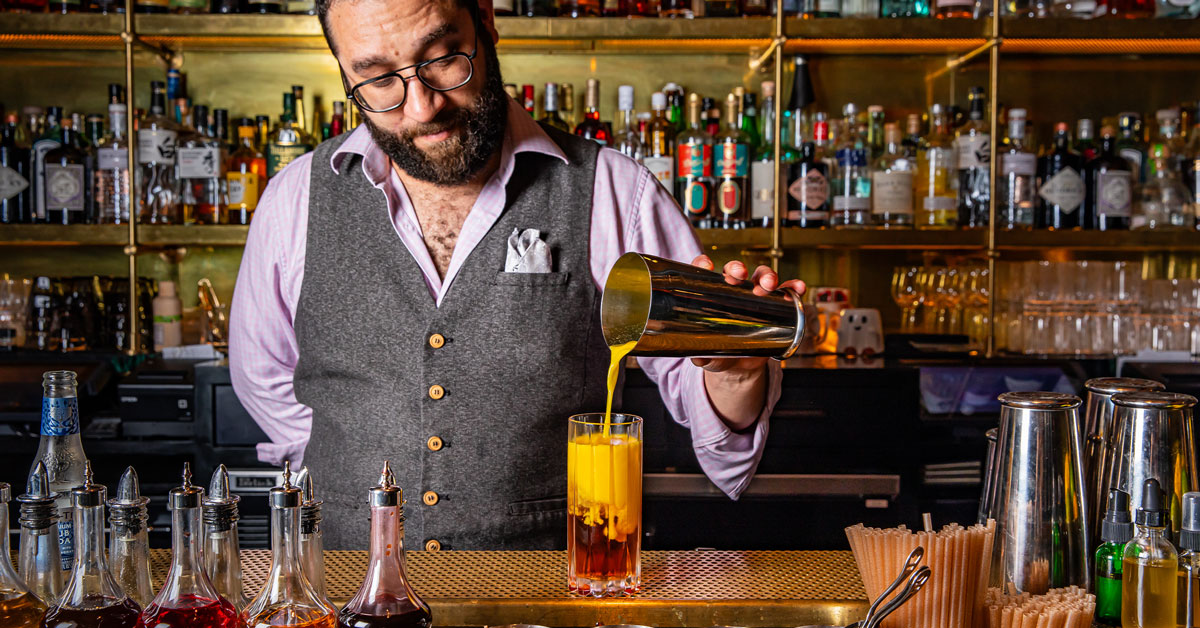It’s impossible to say for certain what the precise elements are that make for a great cocktail. You never really know what mix of ingredients, name and backstory will resonate with people to elevate a drink from just another assemblage of ingredients to something enduringly memorable. Take the Bocce Ball, for instance. It’s just one among thousands of recipes in the 1970s cocktail tome Jones’ Complete Barguide that have been passed over for decades. But, perhaps due to its alliterative, sporty name, or its unassuming, ubiquitous ingredients—simply amaretto liqueur, orange juice and soda water—the drink stood out to Max Green.
When putting together the menu for the recently opened Bronze Owl in New York City, Green, who works as the bar director, was looking for drinks that suited the Italian-leaning vibe of the space. The Bocce Ball bubbled up as a drink that could be transformed from a relic of the Fern Bar era to something that felt right at home in a modern cocktail bar. “It’s great in that every piece of it hits: The drink tastes nice, the name is obviously catchy. It fits the bill,” says Green. He had heard of the drink before, but was reminded of it by Al Sotack, a New York–based bartender who has not only spent a great deal of time extolling the virtues of Stan Jones’ Barguide, but is also the brand developer for Bellaventura, the producer of Adriatico Amaretto, the brand used in Green’s version.
“It’s a really great application of amaretto—and this is from somebody who doesn’t particularly like orange juice,” says Sotack of the Bocce Ball. And while it obviously behooves someone to advocate for the usage of their employer’s products, Green says the inclusion of Adriatico, which has around half the sugar typically found in other expressions of the liqueur, allows the drink to hew closely to the three-ingredient version found in Jones’ original recipe. In other words, there’s no need to cut the amaretto with another ingredient to buffer against any potential cloying sweetness. “We made one [Bocce Ball] splitting the amaretto with vodka,” Green recounts, but that version took away “the delightful high notes” that were found in the all-amaretto version.
That’s not to say that The Bronze Owl’s Bocce Ball is a 1:1 rendition of Jones’ original. Green includes dashes of both Peychaud’s and orange bitters to “add a little bit of fruit and a little bit of dryness.” Green’s version also benefits from what he calls “fluffy” orange juice, which fans of modern renditions of the Garibaldi will be familiar with. Instead of juicing oranges with a traditional citrus juicer, staff at The Bronze Owl uses a centrifugal juicer with rapidly rotating blades that significantly aerate the juice.
Finally, the drink is built, “not exactly as a Pousse Café,” says Green, but deliberately layered so there is a pleasing gradient thanks to the different densities of the liqueur, juice and soda; guests are then invited to mix it up once it’s served. The Bronze Owl’s Bocce Ball has one final trick up its sleeve: a small half-moon of fennel-and-orange biscotti made by the bar’s pastry chef, Romina Peixoto.
The general reception among guests has been positive, with an interesting coalition of amaretto superfans and drinkers simply looking for a peculiar or unexpected option all gravitating toward the Bocce Ball. “For American palates and the American perception of ‘classic cocktails,’ this definitely falls outside of it,” says Green. “That’s why these drinks exist on the menu, for those who want something a little off the beaten path.”











